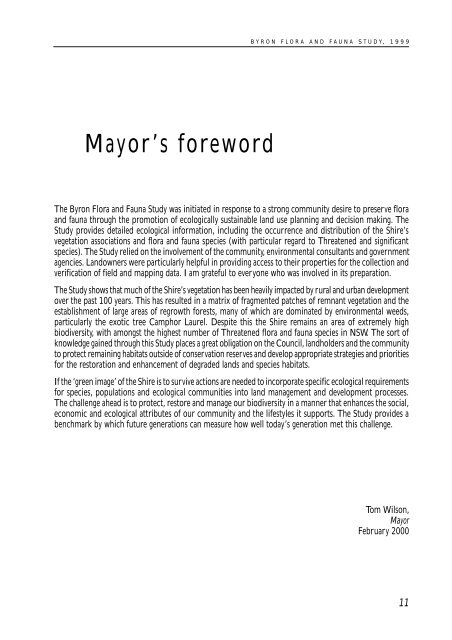Byron Flora and Fauna Study 1999 - Byron Shire Council
Byron Flora and Fauna Study 1999 - Byron Shire Council
Byron Flora and Fauna Study 1999 - Byron Shire Council
You also want an ePaper? Increase the reach of your titles
YUMPU automatically turns print PDFs into web optimized ePapers that Google loves.
BYRON FLORA AND FAUNA STUDY, <strong>1999</strong><br />
Mayor’s foreword<br />
The <strong>Byron</strong> <strong>Flora</strong> <strong>and</strong> <strong>Fauna</strong> <strong>Study</strong> was initiated in response to a strong community desire to preserve flora<br />
<strong>and</strong> fauna through the promotion of ecologically sustainable l<strong>and</strong> use planning <strong>and</strong> decision making. The<br />
<strong>Study</strong> provides detailed ecological information, including the occurrence <strong>and</strong> distribution of the <strong>Shire</strong>’s<br />
vegetation associations <strong>and</strong> flora <strong>and</strong> fauna species (with particular regard to Threatened <strong>and</strong> significant<br />
species). The <strong>Study</strong> relied on the involvement of the community, environmental consultants <strong>and</strong> government<br />
agencies. L<strong>and</strong>owners were particularly helpful in providing access to their properties for the collection <strong>and</strong><br />
verification of field <strong>and</strong> mapping data. I am grateful to everyone who was involved in its preparation.<br />
The <strong>Study</strong> shows that much of the <strong>Shire</strong>’s vegetation has been heavily impacted by rural <strong>and</strong> urban development<br />
over the past 100 years. This has resulted in a matrix of fragmented patches of remnant vegetation <strong>and</strong> the<br />
establishment of large areas of regrowth forests, many of which are dominated by environmental weeds,<br />
particularly the exotic tree Camphor Laurel. Despite this the <strong>Shire</strong> remains an area of extremely high<br />
biodiversity, with amongst the highest number of Threatened flora <strong>and</strong> fauna species in NSW. The sort of<br />
knowledge gained through this <strong>Study</strong> places a great obligation on the <strong>Council</strong>, l<strong>and</strong>holders <strong>and</strong> the community<br />
to protect remaining habitats outside of conservation reserves <strong>and</strong> develop appropriate strategies <strong>and</strong> priorities<br />
for the restoration <strong>and</strong> enhancement of degraded l<strong>and</strong>s <strong>and</strong> species habitats.<br />
If the ‘green image’ of the <strong>Shire</strong> is to survive actions are needed to incorporate specific ecological requirements<br />
for species, populations <strong>and</strong> ecological communities into l<strong>and</strong> management <strong>and</strong> development processes.<br />
The challenge ahead is to protect, restore <strong>and</strong> manage our biodiversity in a manner that enhances the social,<br />
economic <strong>and</strong> ecological attributes of our community <strong>and</strong> the lifestyles it supports. The <strong>Study</strong> provides a<br />
benchmark by which future generations can measure how well today’s generation met this challenge.<br />
Tom Wilson,<br />
Mayor<br />
February 2000<br />
11

















